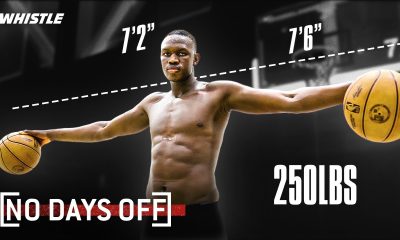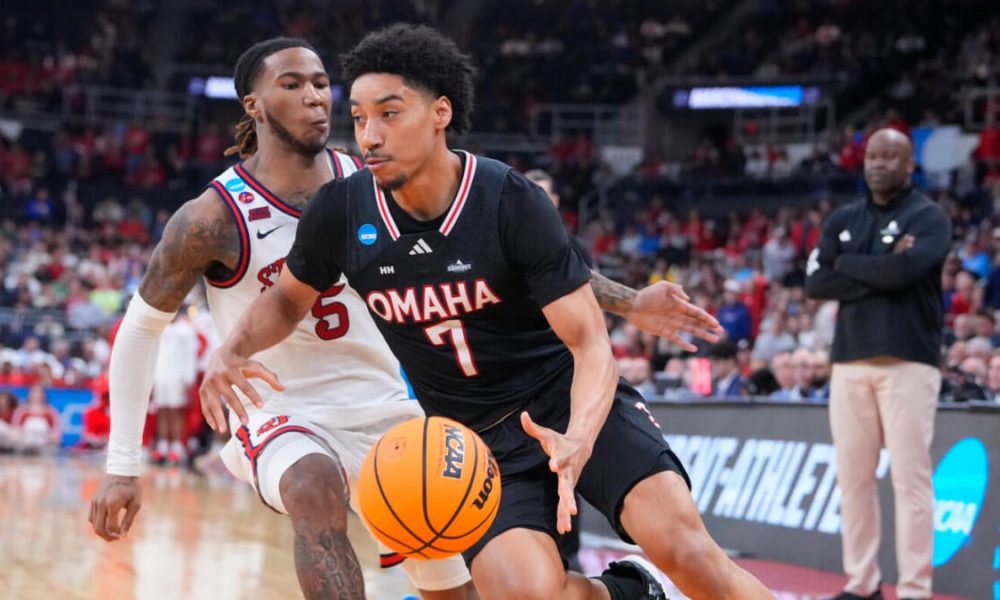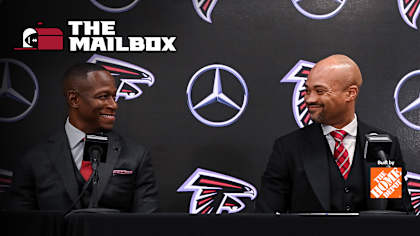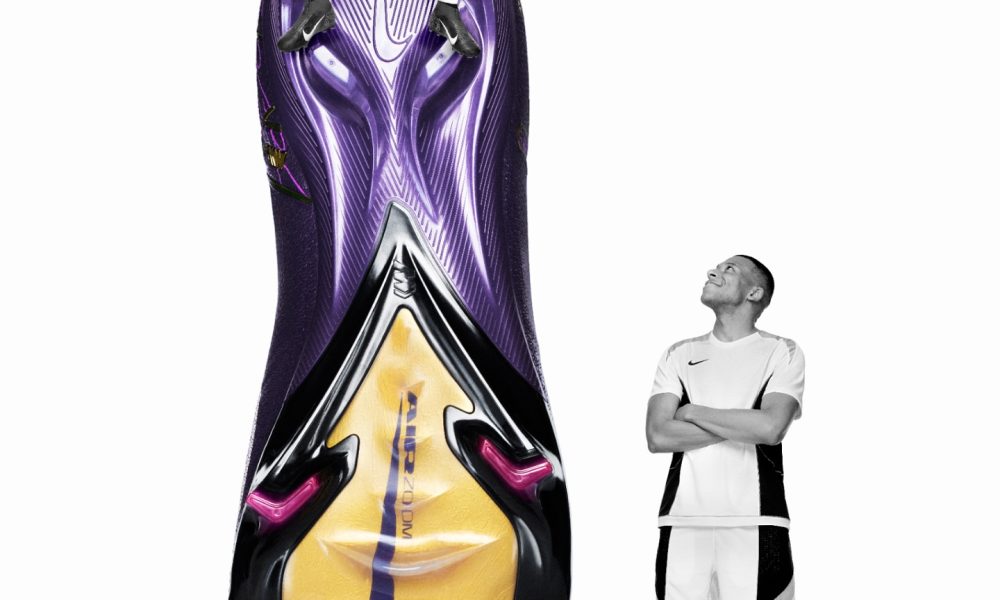Texas volleyball, with its first No. 1 seed in three years, began what coach Jerritt Elliott hopes is a three-week journey through the NCAA Tournament Friday with a resounding sweep over Florida A&M Friday at Gregory Gymnasium.
Sports
Inside Amazon's first year streaming the NHL and whether their Rogers deal will continue
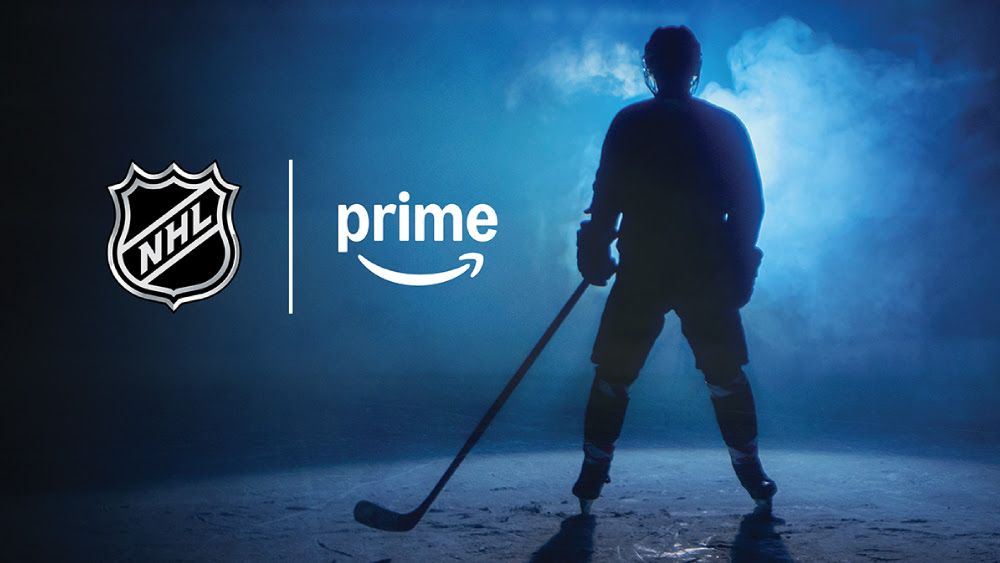
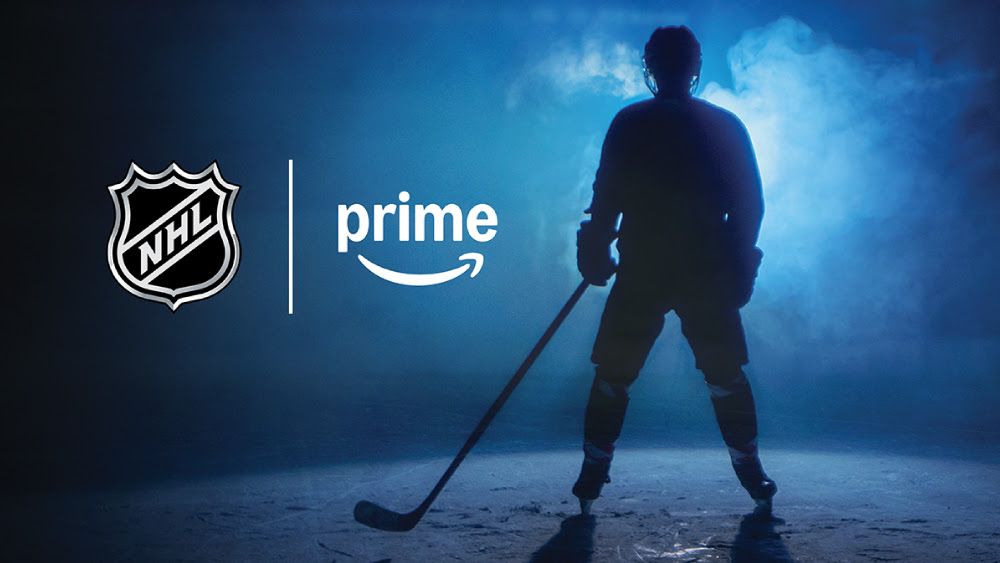

When the NHL and Rogers announced last April that Amazon had signed a two-year deal to produce and stream Monday NHL games exclusively in Canada, it was reasonable to wonder about Amazon Prime Video’s long-term play.
Now that the league has announced a 12-year extension of Rogers’ exclusive Canadian broadcast rights — beginning at the end of next season, when the current deal expires — we have more insight into the future of hockey broadcasts on Canadian screens. Prime Video launched “Monday Night Hockey” this season by subletting one night’s worth of those rights from Rogers. It will continue next season, essentially giving Amazon a two-year audition for a larger portion of NHL broadcasting rights in the future.
Advertisement
If Prime Video pulled off “Monday Night Hockey” with any degree of success, could the streaming giant angle for a bigger piece of the Canadian NHL deal after its first two years are up?
Tony Staffieri, Rogers president and CEO, said on Wednesday that Rogers has every intention of subletting its exclusive rights.
“Yes, we’ll look to it — as a possibility and as a strong possibility,” Staffieri said. “Today, we sublicense French content as well as streaming with Amazon. Those have been terrific partnerships and as we look to the next 12 years, the agreement with the NHL is that we’ll look for opportunities to continue to sublicense where they make sense.”
Amazon declined to comment on how Rogers’ announcement affects the future of Prime Video and NHL broadcasts. Still, it has to be good news when the president of Rogers is asked about your existing sub-lease and says, “Those have been terrific partnerships.”
Rogers paid $11 billion for 12 years’ worth of exclusive Canadian rights starting in 2026-27. One way to recoup some of its investment — and spare itself from taxing Sportsnet staff with the heavy lift of broadcasting every Canadian game — is to continue those subleasing agreements, whether to Amazon, RDS or on new frontiers.
Whether Prime Video continues its Monday night broadcasts, picks a new night or expands to add a second night remains to be seen; what’s clear is that there is opportunity for it to grow its NHL footprint heading into 2026-27.
“There is nothing more valuable in this country from a media standpoint than having the rights to the NHL,” NHL commissioner Gary Bettman said at the joint news conference.
How much of that value will belong to Amazon? Now that Prime Video has completed most of its first season, we have insight into how they’ve approached it. There are elements of Amazon’s production during their Monday night broadcast (and in its behind-the-scenes documentary series “Faceoff”) that are resource-intensive. Prime Video has committed budget in the form of on- and off-air broadcasting talent that travels from one city to the next. It broadcasts with features like AI-enhanced slow-motion replays, Dolby 5.1 surround sound and warm-up footage, using a 1080p HD resolution other Canadian broadcasts don’t yet match.
Advertisement
In an effort to put a focus on the Canadian cities, the broadcast team is traveling from city to city for all 26 games. Prime Video’s goal is to make each city feel like a character in the broadcast — something they’ve achieved in part through that travel and in part through the collection of additional footage of each city. The other way Prime Video has made the most of its resources is hiring top on- and off-air talent, said Mark Shopiro, head of Prime Video Canada.
John Forslund was one of Prime Video’s key NHL hires, topping a talent list that includes Adnan Virk, Andi Petrillo, Thomas Hickey, Blake Bolden, Jody Shelley and Shane Hnidy. Forslund, whose nearly 40 years of play-calling experience include TNT, ESPN, NBC, and a host of other American broadcasts, recalls that Prime Video’s pitch to him was unique.
“In my career, no one’s ever asked me, ‘What’s your opinion on how to call a hockey game?’” Forslund said. Forlsund told his wife after the interview that it was the first time in his career that it felt like someone cared how he thought a hockey game should be presented. The feeling stuck with him.
Forslund said the beauty of an NHL game is that there are 20 players on each team who could become the story on any given night. He does his homework on each one, so that he’s ready no matter what happens instead of trying to shoehorn topics into the game in advance.
Shopiro also points to Prime Video’s hiring success behind the camera. Each Prime Video game is directed by Mark Askin, who produced Toronto Maple Leafs games for 36 years, including for “Hockey Night in Canada.” He was coaxed out of retirement. Seated at the front of the truck, watching the live action through all of Amazon’s angles simultaneously, Askin spends each broadcast calling out instructions to the team of technicians who turn live audio and video into the produced broadcast. Every time there’s a big play — or a subtle, important one — Askin calls cues to his crew, with staff responsible for preparing each color-coded feed in real time.
Advertisement
Is all of this investment working? Prime Video says it is.
Their “Monday Night Hockey” broadcast delivers significantly younger audiences than other broadcasts, according to data provided by Prime Video. The median age for their viewings is 43 years old, compared to 55 for last season’s Monday night games and 54 for “Hockey Night in Canada” this season, with growth in various demographic ranges from age 18 to 54. Prime Video’s analytics also show that the average length of a watching session has increased by 33 percent compared to last season.
Live sports are part of the next streaming boom, with Prime Video, Apple TV and others competing with each other for the eyeballs they don’t already get from film and TV series. Now that Rogers has secured another 12 years worth of broadcast rights, will Prime continue its partnership?
“I can’t speculate on future rights. I think what I can say is that we remain committed and focused to getting the game right in our first season of the deal that we’re on,” Shopiro said. “We’re always looking at opportunities for how we can bring value and enhance the Prime membership and believe that live sport has a big part to play in that.”
(Top photo of the Prime Video broadcast truck: Courtesy Kendra Hope Penner)
Sports
No. 3 Volleyball sweeps Florida A&M, 3-0, to advance in NCAA Tournament

AUSTIN, Texas. — The No. 3 Texas Volleyball team improved to 42-0 in the NCAA First Round after sweeping Florida A&M (25-11, 25-8, 25-14). The Longhorns improved to 24-3 on the season behind Emma Halter’s historic night on defense.
Halter moved up to No. 8 on the all-time Texas digs list with 25 tonight, making it a 1,282 total. Halter also broke the Texas record in three-set matches with 25 digs. She’s now the fourth Longhorn to record 25, joining Dariam Acevedo (2006), Adrian Greenmail (2001) and Carrie Busch (1995).
Ayden Ames matched her career high with eight blocks, leading the Longhorns to tally nine total. Ramsey Gary also recorded a season high three aces for a match high. The Longhorns recorded 42 kills to the Rattlers 15, holding them to a -.027 – the lowest opponent hitting percentage of the season.
Set One: Texas dominated the opening set 25-11, limiting the Rattlers to a .000 attacking percentage while hitting .414 themselves. Torrey Stafford led the charge with five kills and a .455 hitting percentage. Swindle recorded nine assists and Halter registered 10 digs. The Texas defense totaled four and a half blocks in the first set.
Set Two: The Longhorns held the Rattlers to only eight points, tying their opponent season low in the second set. Stafford added six more kills out of her 13 total, while Texas put up four team blocks behind Ames’ four.
Set Three: The Longhorns saw Cari Spears add four kills and Whitney Lauenstein add one of her five kills in the third. Lauenstein also totaled four blocks on the night and hit for .571.
Up next Texas will face off against No. 25 Penn State in the Second Round of the NCAA Tournament on Saturday, Dec. 6 at 6:30 p.m. CT on ESPN+.
Sports
Volleyball sees season end in NCAA DII Second Round

WINGATE, N.C. – Another successful Lenoir-Rhyne Volleyball season has come to an end. The Bears fell 3-1 to #3 seeded Anderson in the NCAA DII Tournament second round on Friday, closing their season at 23-8.
Emmaleigh Allen led the team with 13 kills while Emmie Modlin and Alicia Barbarito combined for 38 assists.
INSIDE THE MATCHUP
Final: Anderson 3, Lenoir-Rhyne 1 (29-27, 20-25, 25-9, 25-18)
Records: Anderson (23-7, 16-4 SAC), Lenoir-Rhyne (23-8, 14-4 SAC)
Location: Wingate, NC | Cuddy Arena
STORY OF THE MATCH:
- Down early on, the Bears went on a late 4-0 run to tie the score at 22 in the first set.
- Lenoir-Rhyne had set point at 26-25, but a 4-1 run from Anderson gave the Trojans the 29-27 set victory.
- Hadley Prince produced back-to-back service aces to help Lenoir-Rhyne win the second set 25-20.
- Anderson dominated the third set 25-9, finishing with a .317 hitting % and just four attack errors.
- Lenoir-Rhyne responded early in the fourth set, jumping ahead 6-3.
- The Trojans did not look back after tying the match at 7, keeping the Bears an arms length away the rest of the set.
STATS OF THE GAME:
- Anderson finished with an advantage in kills (59-to-46), hitting % (.276-to-.127), and assists (57-to-43).
- There were a combined 38 block assists and solo blocks between the two teams.
- Kayli Cleaver and Averie Dale combined for 11 total blocks
- Hadley Prince led the team with 19 digs while Addison Vary collected two service aces.
BEYOND THE BOXSCORE:
- This was the fourth meeting this season between the Bears and Trojans, with each team winning twice.
- Emmaleigh Allen generated her sixth double-double this season after finishing with 13 kills and 16 digs.
- Kayli Cleaver finished the season as the team leader in kills (363) and kills per set (3.36) for the second straight season.
- The 2025 Lenoir-Rhyne Volleyball Team finished with the second highest hitting % in school history at .235, just .05 away from the record held by the the 1998 squad.
- Averie Dale finished with a .399 hitting %, which ties the program’s individual season record held by Michelle Baity in 1999.
- The Bears produced their third straight season with 20 or more wins and set a new program record winning 13 matches at home.
- Nicole Barringer now holds an 87-35 record in four years as the Bears’ head coach.
- Barringer is the first coach in program history to lead the team to three consecutive NCAA Tournament appearances.
Sports
Volleyball’s Season Ends In Round Of 32 to No. 3 Wisconsin
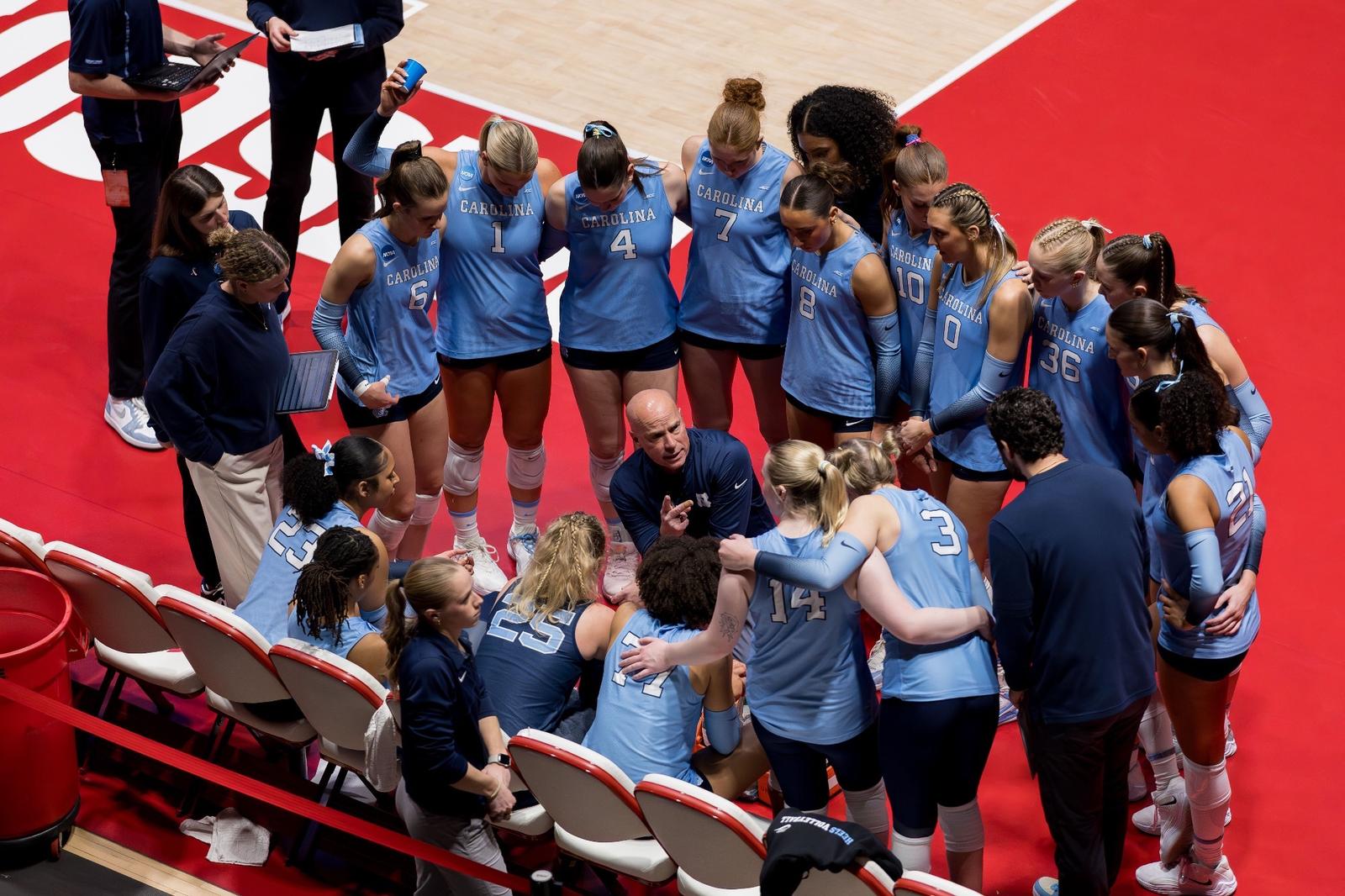
The Tar Heels improved after each set, raising their hitting percentage from .146 to .317. Laynie Smith led the way offensively as she hit .400 with seven kills on only 15 attacks.
Carolina dropped the first set 25-14, but Bridget Malone was the bright spot as she came off the bench and hit above .444 with four kills.
The Tar Heels had a much better second set, putting together an impressive 7-2 run in the middle of the match that brought the score to 17-18. The Tar Heels continued to fight back against the top-ranked Badgers.
The Tar Heels battled back in the third set as the final set was tied 19 times and there were ten lead changes.
Maddy May wrapped up her legendary Tar Heel career tonight. May played in every single set (445) of every single match (118) over her four-year career. May currently sits third all-time in program history with 1622 digs. The senior closed out her time in Chapel Hill on a high note, as she was named Second Team All-ACC for the first time in her career.
Sports
Arizona State volleyball advances to NCAA Tournament second round
Dec. 5, 2025, 7:31 a.m. MT
- Arizona State volleyball swept Coppin State in the first round of the NCAA Tournament.
- ASU will now face Utah State in the second round for a chance to advance to the Sweet 16.
No. 2 seed Arizona State volleyball completed the first step in the NCAA Tournament, taking care of Coppin State on Thursday, Dec. 4, at Desert Financial Arena with a sweep, 25-11, 25-14, 25-12.
The Sun Devils, ranked eighth in the nation, earned the opportunity to host the first two rounds at home and were all business to start the match. ASU never surrendered a lead against the Eagles and even held them to a negative hitting percentage of -.082 for the night.
TaKenya Stafford led CSU with five kills.
“At the beginning, we talked about going into this game with a lot of energy and that carried over into the game and we could feel it, as well as the fans bringing that to the court as well,” outside hitter Tatum Parrott said.
The Sun Devils have been dominant at home this season, but have struggled with their starts in past games. The key to avoiding the mental lapses came from the service line.
ASU was aggressive with its serving to start the first set, getting a 4-0 advantage in service aces as the Eagles sided out only 36% of the time in that set. ASU also finished both the first and third sets with a 6-0 run.
“I was proud that they came out and did this because we’ve had some lapses this season, especially in the first set and we kind of take our foot off the gas,” coach JJ Van Niel said. “That was my message, everything we’re doing today is preparing us for tomorrow night (second round against Utah State), so we had high efforts today and we’ll have high efforts tomorrow.”
With ASU holding a lead over CSU throughout the match, Van Niel brought in several players who normally don’t see a lot of action. Even with ample rest, star opposite Noemie Glover had a sizable role in ASU’s victory with 14 kills while hitting a blistering .522.
“You never know what will happen. I’ve been in a spot where a key player goes down in the tournament and you got to be ready,” Van Niel said. “I want to get us all in there and get some reps just in case, so you just try a couple of things out and see what happens.”
CSU applied the pressure on ASU midway through the second set and scored two consecutive points to get within three.
But middle blocker Colby Neal responded for ASU with a kill on the next point, and then Parrott blocked CSU’s Ayanna Pharoah for a 16-11 lead.
ASU’s middle blockers were efficient as Neal provided steadiness whenever the Sun Devils would slip up against CSU and finished with five kills on .556 hitting. Ella Lomigora racked up two solo blocks and a team-high six block assists.
The Eagles didn’t go away, as Bailey Miller’s attack error gave them the point, but Neal once again delivered with a kill on the next point for a 17-12 lead for ASU.
Three consecutive errors from CSU gave ASU a 20-12 lead, which then led to the Sun Devils allowing only two more points from the Eagles to win the set.
ASU finished with a relatively clean game with seven errors, while forcing 26 from CSU. However, the second round is going to be much more difficult to get through. Even though there are a few holdovers from last year’s tournament team, the memories of the second-round loss to Texas A&M still linger.
Utah State, the winner of a thrilling five-set match against Tennessee, is a tough matchup. The teams meet in the second round on Friday, Dec. 5, at 6 p.m. MST at Desert Financial Arena. The winner advances to the Sweet 16.
“I still remember what happened last year,” Van Niel said. “But I don’t think my job is to remind them about it. It’s really (focusing on) we just need to come out and play our game of volleyball and see what happens.
“We can’t control our opponent. Utah State did a great job tonight, and I can’t control how well they play. All we can control is our effort and intensity.”
Reach the reporter at jenna.ortiz@arizonarepublic.com, as well as @jennarortiz on X.
Catch the best high school sports coverage in the state. Sign up forAzcentral Preps Now. And be sure to subscribe to ourdaily sports newsletters so you don’t miss a thing.
Sports
Purdue volleyball vs Baylor NCAA tournament final score, game result, next
8:25 pm ET December 5, 2025
When is Purdue volleyball’s next game? Purdue volleyball next game in Sweet 16. Who does Purdue volleyball play next?
Aaron Ferguson
Barring an upset, the Boilers are headed to Pittsburgh, the No. 1 seed in their quadrant. Times for next weekend are to be determined, and Purdue will know its opponent late Saturday night. Florida punched its ticket with a sweep of No. 7-seed Rice in an upset, and the Gators will play either No. 2 SMU or Central Arkansas.
It may set up a potential rematch with SMU, which Purdue beat 3-1 on a neutral court.
8:21 pm ET December 5, 2025
Purdue volleyball highlights vs Baylor
Aaron Ferguson
Limited highlights circulating, but here’s how it looked inside Holloway Gymnasium:
8:18 pm ET December 5, 2025
Purdue volleyball stats vs Baylor
Aaron Ferguson
Purdue’s offense was brilliant all night with a .405 clip and three hitters in double figures: Kenna Wollard, 18-3-34 (.441); Akasha Anderson, 17-4-36 (.361); and Lindsey Miller, 10-1-16 (.562). Taylor Anderson spread it around with 45 assists, adding seven digs, three blocks and a kill.
The Boilers block had a 12-5 edge over Baylor, led by Dior Charles (five) and Miller (four) in the middle. Charles added seven kills. And while Grace Heaney struggled swinging early on the right side, she was key in other areas with four blocks, three service aces and three digs to go with her four kills.
Baylor was held to hitting .250 for the match, and began settling in over the final two sets. It played five against Arkansas State on Thursday night, and struggled against Purdue’s block early, and compounded matters with 11 service errors. Though, Purdue had 13 service errors.
Victoria Davis was key with 13 kills (.458), but Baylor began spreading the attack out and used 13 players to wear down Purdue’s block through the middle part of the match.
8:10 pm ET December 5, 2025
Purdue volleyball score, result vs Baylor in NCAA tournament game today
Aaron Ferguson
Taylor Anderson with a solo block on a joust at the net for the four-set win, 25-16, 25-19, 23-25, 25-20. Impressive resolve in what wasn’t a perfect match for the Boilers to close out their Holloway Gymnasium portion of the schedule.
Purdue advances to the Sweet 16 for the third straight season, and fourth in five. An impressive feat for a team that lost 92.5% of its offensive production.
8:05 pm ET December 5, 2025
Coach Dave Shondell not happy with officiating in Purdue volleyball game
Aaron Ferguson
Coach Dave Shondell effectively yelled a variation of, “What are you doing,” as he challenged a potential touch on the last point. He was probably more upset over what appeared to be a possible carry. He lost the challenge as it goes out, thus making it 19-17 Purdue in the fourth set.
Shondell is out of challenges for the fourth set. He’ll get an extra should it go to a fifth set.
7:58 pm ET December 5, 2025
Score of Purdue volleyball game vs Baylor
Aaron Ferguson
The Bears have spread out their attack to keep Purdue’s block off balance. The Boilers have 10 blocks but none in the fourth set. They led 16-10 but Baylor is on a 4-0 run to force a Dave Shondell timeout.
7:53 pm ET December 5, 2025
Purdue volleyball score vs Baylor in NCAA tournament second round today
Aaron Ferguson
The Boilermakers have three straight points to take a 14-9 lead in the fourth set, leading 2-1. Baylor takes a timeout to try and halt matters. Purdue is hitting .538 in the set as Kenna Wollard (15), Akasha Anderson (15) and Lindsey Miller (10) all have at least 10 kills.
7:44 pm ET December 5, 2025
Purdue volleyball score vs Baylor tonight in NCAA tournament
Aaron Ferguson
Baylor takes the third set, 25-23, and trails Purdue 2-1 after three sets. The Bears hit .371 in the set and are led by Victoria Davis with 12 kills (.524).
Purdue hit .333, its worst of the match so far, in the set, and even with three service aces, it couldn’t overcome passing issues late in the set.
7:31 pm ET December 5, 2025
Baylor scoring run takes set lead against Purdue volleyball
Aaron Ferguson
That’s four straight points for the Bears, forcing Dave Shondell to take a timeout, as overpasses continue to be an issue for Purdue. Baylor challenged that setter Taylor Anderson went over the net and won. It’s 21-20 Bears, needing to keep their season alive in Set 3.
7:22 pm ET December 5, 2025
Purdue volleyball timeout needed as Baylor charges back
Aaron Ferguson
The Boilers take a timeout as their passing has taking a toll on this third set, seeing their lead trimmed to 17-15 after a pair of overpasses.
7:17 pm ET December 5, 2025
Purdue volleyball score vs Baylor tonight in NCAA tournament
Aaron Ferguson
The Boilers win the race to the media timeout, leading 15-10 at the break. They continue their hot hitting in the third set at .438. It’s been Baylor’s best set in efficiency so far at .263 but it also has three service errors.
7:13 pm ET December 5, 2025
Purdue volleyball score vs Baylor tonight in NCAA tournament
Aaron Ferguson
Sienna Foster checks in to serve for the Boilers, who lead 11-8 looking for a sweep in Set 3.
7:00 pm ET December 5, 2025
Purdue volleyball score tonight vs Baylor
Aaron Ferguson
Baylor had a nice 6-1 run to pull within 17-16, but seemingly ran out of steam. The Boilers take a 2-0 lead after a 25-19 edge in Set 2. The Boilers hit .452, and are at .466 for the match. They’re led by an errorless Kenna Wollard with 10 kills (.714). Purdue also has an 8-1 advantage in blocks.
After 70 swings in Thursday night’s five-set win, Baylor’s Ksenia Rakhmanchik has five kills on 19 swings and three errors (.105).
6:51 pm ET December 5, 2025
Baylor run forces Purdue volleyball timeout
Aaron Ferguson
How about three straight points for the Bears after trailing 16-9? Baylor has rolled through substitutions searching for answers and Brielle Warren hitting 2-0-3 with sister Bailey Warren at 6-3-14.
6:46 pm ET December 5, 2025
Purdue volleyball score vs Baylor
Aaron Ferguson
Defense has been the name of this second set. Purdue is out to a 15-7 lead, forcing a second Baylor timeout. The Bears have a sideout percentage of 53.8%. Purdue’s? Boilers are at 91.7%, meaning a lot of one-and-dones for Baylor’s offense, which is hitting .050 in the second set and .130 for the match.
6:39 pm ET December 5, 2025
Purdue volleyball score vs Baylor in NCAA tournament
Aaron Ferguson
After taking the first set, running away with it, Purdue kept running. Its out to a 9-3 lead in the first to force a Baylor timeout. The Bears are hitting minus-.111 with three errors and two kills on nine swings. Purdue is up to .625 to start the set.
6:29 pm ET December 5, 2025
Score of Purdue volleyball game today vs Baylor
Aaron Ferguson
Purdue takes the first set 25-16 after the Bears led 2-1, but then never settled in offensively. Purdue hit .481 and held the Bears to .176 — perhaps the five-setter last night catching up to Baylor. Just one error for the Boilers, who were led by Akasha Anderson’s five and Kenna Wollard’s four. It was a 5-1 blocking set for the Boilers, too.
6:23 pm ET December 5, 2025
Baylor coach has conversation with setter Harley Kreck
Harley Kreck directed an aggressive offense in a five-set win last night, but is getting encouragement from her coach as Baylor takes a timeout, trailing Purdue 19-13 in the first set.
6:20 pm ET December 5, 2025
Purdue volleyball run forces Baylor to take timeout
Aaron Ferguson
The Bears needed a timeout as Purdue scored twice more after the media timeout, a 3-0 run, despite Baylor hitting .409. It does have three service errors, though. It’s 17-12 Purdue.
6:18 pm ET December 5, 2025
Score of Purdue volleyball game vs Baylor in NCAA tournament today
Aaron Ferguson
Purdue wins the race to the media timeout, taking a 15-12 lead. It’s been an errorless set so far for Purdue, 9-0-13 (.692), with Kenna Wollard (three kills) and Lindsey Miller (two) perfect, and Akasha Anderson pacing the match with four kills (.800).
6:10 pm ET December 5, 2025
Purdue volleyball loses challenge in first set
Aaron Ferguson
Dave Shondell’s challenge failed, thus it is 8-5 Baylor and the Boilers have one fewer challenge for the night.
6:09 pm ET December 5, 2025
Purdue volleyball picks it up after slow start against Baylor
Aaron Ferguson
Baylor took an early lead, so early that this match was tied 3-3, and then the Boilers scored five of the next six points to take an 8-4 lead.
Coach Dave Shondell is challenging there was no touch and Baylor’s attack sailed out without help.
6:01 pm ET December 5, 2025
First serve on deck for Purdue volleyball vs Baylor in NCAA tournament
Aaron Ferguson
Starting lineups are wrapping up and the match will be underway in minutes.
5:45 pm ET December 5, 2025
Akasha Anderson comes up in clutch time for Purdue volleyball
Aaron Ferguson
Akasha Anderson transferred most recently from Michigan State, where she spent her lone postseason at home. After arriving in West Lafayette, “Kash” has earned her nickname as she showed Thursday night.
5:15 pm ET December 5, 2025
How Purdue volleyball advanced in NCAA tournament vs Wright State
Aaron Ferguson
The Boilermakers went out to a sweep in the first round of the NCAA tournament. Here’s a look back at how it happened:
5:00 pm ET December 5, 2025
Kenna Wollard leaves lasting impression on Purdue volleyball coach Dave Shondell
Aaron Ferguson
Sitting behind Chloe Chicoine and Eva Hudson, or standing opposite them on the court, was Kenna Wollard. An AVCA player of the year semifinalist, she has clearly restored hope into coach Dave Shondell as he was emotional in talking about her earlier this season.
4:45 pm ET December 5, 2025
How Grace Heaney developed into Purdue volleyball’s efficient hitter
Aaron Ferguson
A native of Nebraska, Grace Heaney stuck with Purdue even through injuries. The redshirt sophomore has been incredibly efficient this season. Here’s more from earlier in the year:
4:30 pm ET December 5, 2025
How transfers found their way into Purdue volleyball culture
Aaron Ferguson
The Monon Spike match was a test of sorts for Akasha Anderson, Dior Charles and several other Purdue transfers. It’s a rivalry, in coach Dave Shondell’s eyes, and allowed a pair of newcomers to see his competitive side. Here’s what it meant to them:
4:15 pm ET December 5, 2025
Dave Shondell considered retirement but Purdue volleyball reenergized him
Aaron Ferguson
Dave Shondell spoke candidly about the transfers of Chloe Chicoine and Eva Hudson, to the point he was considering retiring as the new age of player empowerment and movement hit his program — hit Purdue. So what did this season’s team leave as an impression on him? It’s in their motto, “Ever grateful,” he said.
From my exclusive conversations with the 67-year-old Shondell:
4:05 pm ET December 5, 2025
What time Purdue volleyball play in the NCAA tournament? Start time for Purdue volleyball vs Baylor
Aaron Ferguson
First serve is scheduled for 6 p.m. at Holloway Gymnasium.
4:01 pm ET December 5, 2025
Where to watch Purdue volleyball in the NCAA Tournament; what channel is Purdue volleyball on tonight, Dec. 5?
Aaron Ferguson
ESPN+
Watch Purdue volleyball on ESPN+
3:55 pm ET December 5, 2025
Purdue volleyball tickets
Aaron Ferguson
Purdue says all-session tickets are sold out.
Our team of savvy editors independently handpicks all recommendations. If you purchase through our links, the USA Today Network may earn a commission. Prices were accurate at the time of publication but may change.
Sports
Live updates, how to watch
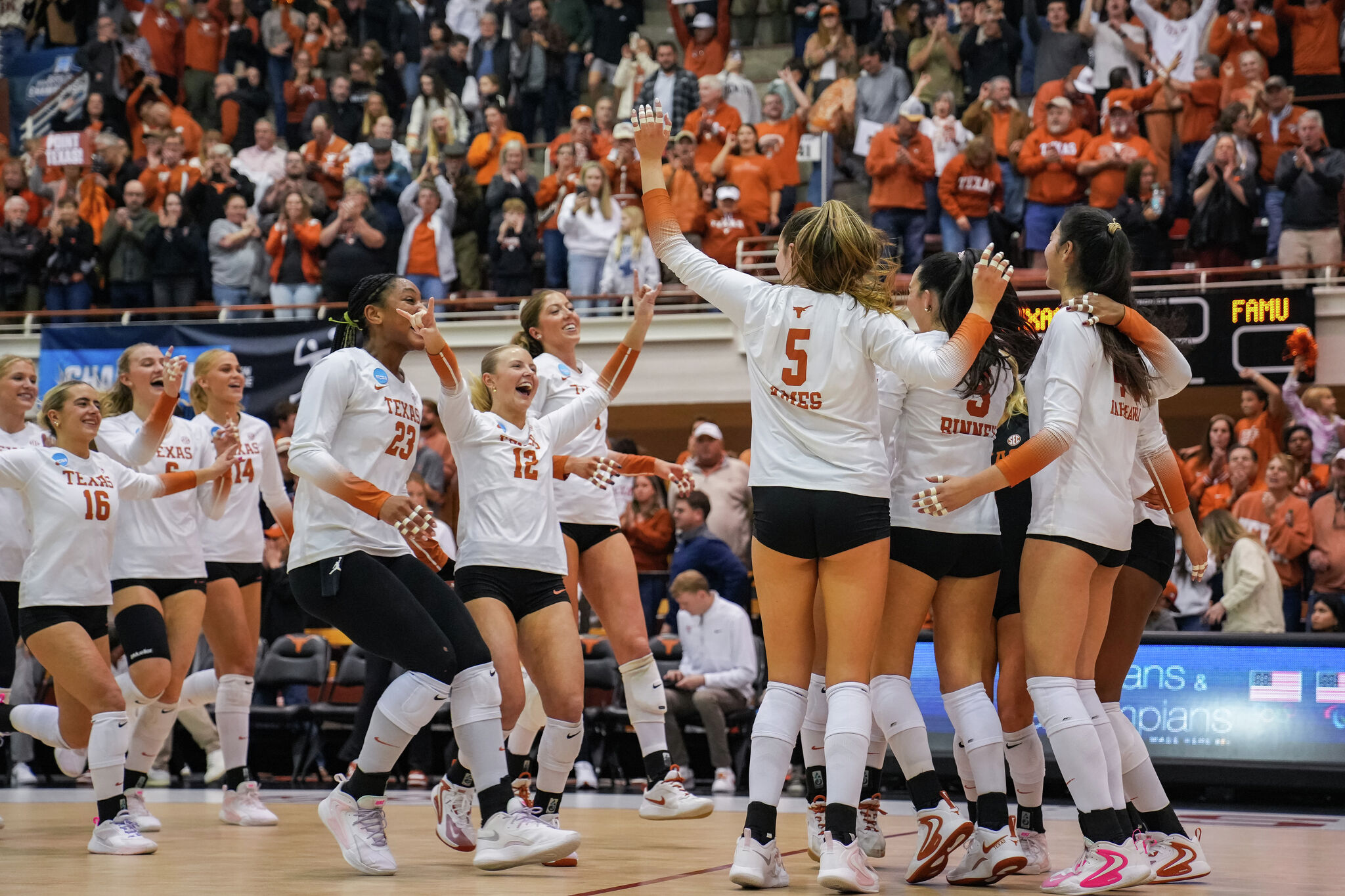

The Longhorns celebrate after winning the game against Florida A&M during the first round of the NCAA Tournament at Gregory Gymnasium in Austin, Friday, Dec. 5, 2025.
But the competition will significantly stiffen Saturday when the Longhorns (23-3) face defending national champion Penn State in a second-round meeting. The eighth-seeded Nittany Lions (19-12), which beat South Florida 3-1 in the first game Friday at Gregory Gymnasium, have endured a rocky season that included the September departure of All-American setter Izzy Starck because of mental heath concerns.
Article continues below this ad
But Penn State still has a championship pedigree that includes eight national titles, and the team still has an All-American attacker in 6-foot-6 Kennedy Martin.
“It’s one of the storied programs we have,” said Texas coach Jerritt Elliott, who’s led the Longhorns to three of their five national titles. “Obviously, two tradition-rich programs in the sport, and that makes it great for TV and great for our fans. We’re excited to be part of it.”
Based on how they played against overmatched Florida A&M (14-17), the Longhorns look primed for the challenge. Rattlers coach Gokhan Yilmaz said a Texas defense powered by a record-setting performance by Emma Halter proved more impressive than the array of Longhorn hitters led by Torrey Stafford (13 kills).
“I think their defensive effort was great,” he said. “In a match where everybody knows it would be a lopsided, they didn’t just hang around. They were going after every ball. That’s really impressive to see.”
Article continues below this ad
Halter led that defense with 25 digs, which set a school record for most digs in a 3-set match.
“Honestly, it felt really good from earlier today in warm-ups,” Halter said. “I was just like, ‘I’m kind of feeling it today.’ It’s tournament time. It’s live or die, and so I’m trying to get every ball.”
Read below for a replay and highlights from the Texas Longhorns’ win over the Florida A&M Rattlers in a NCAA Tournament first-round match.
MORE: After long journey to Austin, Texas’ Torrey Stafford leads Longhorns into NCAA volleyball tournament
Article continues below this ad
Torrey Stafford ended with 13 kills, and the Longhorns got contributions from across the lineup in an easy first-round sweep. Up next? Defending champion Penn State.
Stat leaders for Texas: Torrey Stafford with 13 kills, Ella Swindle with 20 assists, Emma Halter with 23 digs and Ayden Ames with seven total blocks. Texas leads 2-0.
Article continues below this ad
FAMU has more hitting errors than kills in this match as Texas continues to work through its bench and eye the champs in a second-round match Saturday. Whitney Lauenstein, one known as “Big Hit Whit” during her time at Nebraska, has four kills on five swings and three blocks off the bench. Texas leads 2-0.
Too much size, too much talent from Texas, which takes a 2-0 lead. Penn State is in the cheap seats watching, but I’m not sure what the Nittany Lions can glean from this match. Texas leads 2-0.
Article continues below this ad
Whitney Lauenstein has been getting some run late in the season for Texas, and she fires a pretty ball. Her first kill of the match leads to another Rattler timeout. Texas leads 1-0.
A service ace from Torrey Stafford caps a quick 3-0 spurt by Texas, and FAMU takes a time out. Texas leads 1-0.
Article continues below this ad
No drama in set one. Torrey Stafford paces Texas with five kills, Ayden Ames has three kills and three blocks, and Emma Halter tallied a whopping 10 digs.
Ayden Ames is having her way at the net for Texas with three kills on three swings and three blocks, but it’s the diving saves from Emma Halter and Rella Binney that really get the crowd going.
Article continues below this ad
That last post may have jinxed FAMU. Texas keeps swinging away, Abby Vander Wal comes off the bench for three quick kills, and Texas is on a 6-0 run.
FAMU is hanging in there early. The Rattler are making Texas work for its kills, and that’s all you can do as a big underdog.
Article continues below this ad
Ayden Ames starts it off with a spike for Texas. NCAA Tournament first round. Winner faces Penn State tomorrow.
Article continues below this ad
Article continues below this ad
Article continues below this ad
Article continues below this ad
Penn State, the defending national champion, shook off a first-set loss and beat South Florida 3-1 and will face either Texas or Florida A&M Saturday at 6:30 p.m. in a second-round matchup. The Nittany Lions (19-12) have endured a rocky season that included the in-season departure of All-American setter Izzy Starck because of mental heath concerns, but they flashed their firepower against South Florida. Texas and Florida A&M will start at 7:08 p.m.
The matchup between Texas and Florida A&M will likely start after its scheduled time of 7 p.m., based on the current battle between Penn State and South Florida. The Longhorns and Rattlers need their allotted warm-up time, so their match will start approximately 30 minutes after the conclusion of Friday’s first match at Gregory Gymnasium. Penn State just took a 2-1 lead after winning the third set.
Article continues below this ad
Article continues below this ad
-
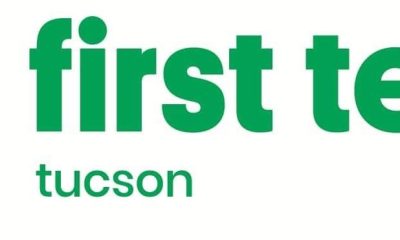
 Rec Sports2 weeks ago
Rec Sports2 weeks agoFirst Tee Winter Registration is open
-

 Rec Sports1 week ago
Rec Sports1 week agoFargo girl, 13, dies after collapsing during school basketball game – Grand Forks Herald
-

 Motorsports2 weeks ago
Motorsports2 weeks agoCPG Brands Like Allegra Are Betting on F1 for the First Time
-
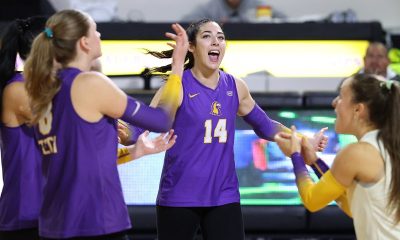
 Sports2 weeks ago
Sports2 weeks agoVolleyball Recaps – November 18
-

 Motorsports2 weeks ago
Motorsports2 weeks agoF1 Las Vegas: Verstappen win, Norris and Piastri DQ tighten 2025 title fight
-
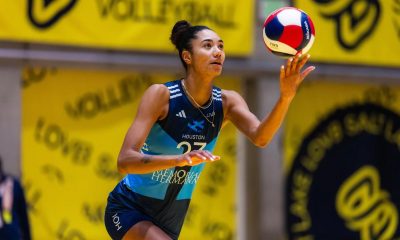
 Sports2 weeks ago
Sports2 weeks agoTwo Pro Volleyball Leagues Serve Up Plans for Minnesota Teams
-

 Sports1 week ago
Sports1 week agoUtah State Announces 2025-26 Indoor Track & Field Schedule
-
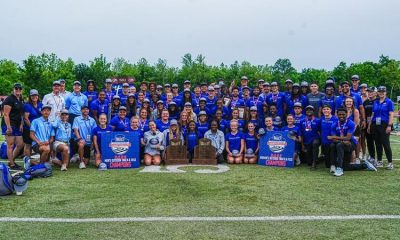
 Sports2 weeks ago
Sports2 weeks agoSycamores unveil 2026 track and field schedule
-

 Sports1 week ago
Sports1 week agoTexas volleyball vs Kentucky game score: Live SEC tournament updates
-
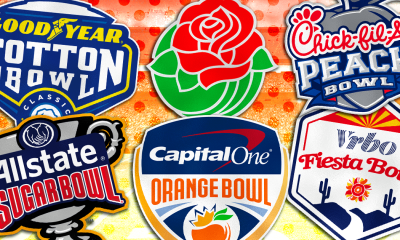
 NIL5 days ago
NIL5 days agoBowl Projections: ESPN predicts 12-team College Football Playoff bracket, full bowl slate after Week 14
















